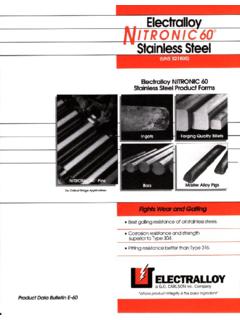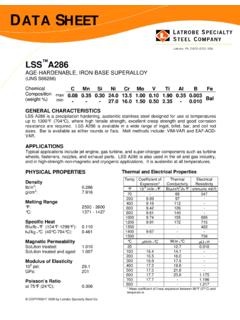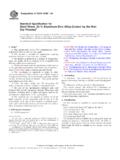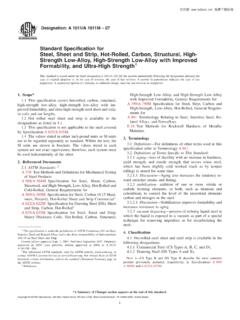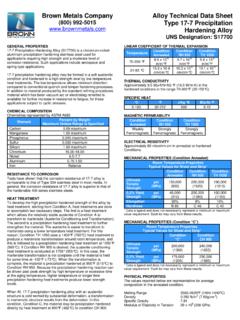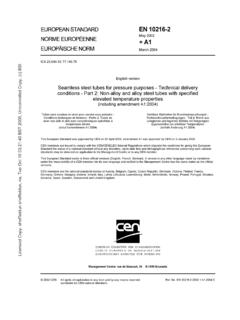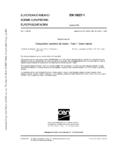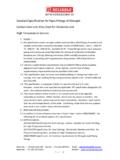Transcription of Stainless Steel AL 17-4™ Precipitation
1 Stainless SteelAL 17-4 PrecipitationHardening Alloy(UNS Designation S17400)Data are typical and should not be construed as maximum or minimumvalues for specification or for final design. Data on any particular piece ofmaterial may vary from those shown herein. Trademark of ATI Properties, PROPERTIESA llegheny Ludlum's AL 17-4 Precipitation HardeningAlloy (S17400), Type 630, is a chromium-nickel-copperprecipitation hardening Stainless Steel used for applica-tions requiring high strength and a moderate level ofcorrosion resistance. High strength is maintained to ap-proximately 600 F (316 C).The S17400 alloy is martensitic in structure in the an-nealed condition and is further strengthened by a lowtemperature treatment which precipitates a copper con-taining phase in the alloy.
2 In comparison to many alloysin the Precipitation hardening family, the S17400 alloyrequires a simple heat treatment; a one step processconducted at a temperature in the range 900 F (482 C)to 1150 F (621 C) depending on the combination ofstrength and toughness desired. A wide range of prop-erties can be produced by this one step heat treatment in the 900 F (482 C) range produceshighest strength, although slightly less than that of al-loys like S17700 or S15700. The latter Precipitation hard-ening alloys generally require more steps to completeheat AND CONDITIONSThe Allegheny Ludlum AL 17-4 Precipitation HardeningAlloy is furnished as plate. Long products are producedby Allvac, an Allegheny Technologies Company. In allforms, the material is furnished in the annealed , Forgings, Tubing and RingsSPECIFICATIONSThe AL 17-4 Precipitation Hardening Alloy (S17400) iscovered by the following wrought product 5604 Sheet, Strip and PlateWelding WireWelding ElectrodesProduct FormAMS 5643 AMS 5825 AMS 5827 AMS 7474 ASTM A 564 ASTM SA 564 ASTM A 693 ASME SA 693 ASTM A 705 ASME SA 705 BoltsBars, Wire and ShapesSheet, Plate and StripForgingsElement Typical Composition (Weight Percent) + are typical and should not be construed as maximum or minimumvalues for specification or for final design.
3 Data on any particular piece ofmaterial may vary from those shown SteelVisit our Website atAL 17-4 ANDOXIDATION RESISTANCET ests have shown that the corrosion resistance ofAL 17-4 Precipitation Hardening Alloy is comparable tothat of Type 304 Stainless Steel in most media. In gen-eral, the corrosion resistance of AL 17-4 alloy is supe-rior to that of the hardenable 400 series Stainless with other Precipitation hardening alloys , AL 17-4 Pre-cipitation Hardening Alloy is more susceptible to stresscorrosion cracking at peak strength. Consequently, inapplications in which chloride stress corrosion crackingis a possibility, the material should be Precipitation hard-ened to produce the lowest hardness compatible withthe intended end use. This is done by heat treating atthe highest temperature which will produce suitableminimum in the annealed condition should not generallybe put into service.
4 In this condition, the material hasan untempered martensite structure and is less ductilethan aged material. The untempered martensite maybe subject to unpredictable brittle fractures. In corro-sive environments, the untempered martensite is moresensitive to embrittling phenomena such as hydrogenembrittlement than material which has had one of theprecipitation hardening heat treatments. Similarly,untempered martensite is more sensitive to chloridestress corrosion cracking than material in which themartensite has been oxidation resistance of the AL 17-4 alloy is superiorto that of 12 percent chromium alloys like Type 410, butslightly inferior to that of Type 430. Precipitation hard-ening will produce surface PROPERTIESC onditionADensityLinear Coefficient ofThermal ExpansionUnits of10-6 / F(10-6 / C)Temperature Range-100 F to +70 F(-73 C to +21 C)+70 F to 800 F(+21 C to +427 C)g / / ( )ConditionH 900 ConditionH 1075 ConditionH ( ) ( ) ( ) ( ) ( ) ( )MagneticPermeabilityStrongly Ferromagneticin all ConditionsThermal ConductivityBtu - ft / hr -ft2 F(W / m - K)70 - 212 F(21 - 100 C)70 - 932 F(21 - 500 C)Electrical ( ) ( ) ( ) ( )98778086 Technical Data BLUE SHEETData are typical and should not be construed as maximum or minimumvalues for specification or for final design.
5 Data on any particular piece ofmaterial may vary from those shown temperature tensile properties can vary substan-tially with heat treatment in the 900 F (482 C) to 1150 F(621 C) range. Values shown below are typical roomtemperature properties which could be expected forMECHANICAL PROPERTIESC onditionAModulus of (196)ConditionH 900 ConditionH 1075 ConditionH (196) (196) (196)Modulus of Rigidity(GPa)106 psi(GPa)106 ( ) ( ) ( ) ( ) OffsetYield Strength110,000760 ConditionH 900 ConditionH 1075 ConditionH 1150180,0001,240135,000930125,000860 Ultimate TensileStrength(MPa)psi(MPa)psi150,0001, 030195,0001,340155,0001,070145,0001,000 Elongation(percentage in 2")HardnessRockwell C scale810101033433128 Stainless SteelAL 17-4 AlloySUMMARY OFHEAT TREATING AL 17-4 ALLOYM inimum Properties Specifiedin Aerospace Material Specification (AMS)
6 5604 Heat Treat toProduceMartensiticStructurePrecipitati on Heat Treatment toProduce Desired StrengthSolutionHeat Treatmentat 1950 F(1066 C)PrecipitationHardening HeatTreatment900 F(482 C)60 minutesCondition H 900 YieldStrengthpsi(MPa)TensileStrengthpsi( MPa)HardnessRc925 F(496 C)4 HoursCondition H 9251025 F(552 C)4 HoursCondition H 10251075 F(579 C)4 HoursCondition H 10751100 F(593 C)4 HoursCondition H 11001150 F(621 C)4 HoursCondition H 1150 Condition A(This is theconditionfurnished byAlleghenyLudlum)170,000(1170)155,000(1 070)145,000(1000)125,000(860)115,000(790 )105,000(725)190,000(1310)170,000(1170)1 55,000(1070)145,000(1000)140,000(965)135 ,000(930)40to4738to4535to4233to3932to382 8to371400 F(760 C)2 Hours +1150 F4 HoursCondition H 1150-Mfrom SA 69375,000(515)115,000(790)26to36 Data are typical and should not be construed as maximum or minimumvalues for specification or for final design.
7 Data on any particular piece ofmaterial may vary from those shown SteelVisit our Website atAL 17-4 Copyright 2006, Allegheny LudlumWELDING AND BRAZINGThe AL 17-4 Precipitation Hardening Alloy is readilywelded using conventional inert gas methods used forstainless grades. Preheating is not usually heat treating is needed to produce the vari-ous Precipitation hardened heat treatment matching filler material is used, properties comparableto those of the parent metal can be produced in theweld by postweld Precipitation hardening heat a number of welding passes are made, a sub-stantial thermal cycling has been conducted on thematerial. More uniform mechanical properties can beobtained by solution annealing the material before con-ducting Precipitation hardening heat treatments.
8 Thesolution anneal has the effect of minimizing the effectsof the thermal the case of welding with non-matching filler, an aus-tenitic Stainless Steel such as 308L or other ductile aus-tenitic should be used. This filler will not produce theprecipitation hardening response, TREATMENTThe AL 17-4 Precipitation Hardening Alloy is furnishedin the annealed condition. This is also called the solu-tion heat treated condition, or Condition A. Annealing isconducted by heat treating at approximately 1900 F(1040 C) to 1950 F (1065 C) and cooling to room tem-perature. In this condition, the material possesses amartensitic structure. As a martensitic structure, theAL 17-4 alloy possesses a relatively high strength andhardness in the annealed condition.
9 The strength andhardness of the material is generally somewhat lowerin the H 1150 overaged develop further increase in strength, the annealedmaterial is Precipitation hardened by heat treatments at900 F (482 C). Heat treatments above 1075 F (579 C)generally result in material softer than material in theannealed condition. The heat treatments are usuallyspecified as follows:The Precipitation hardening reaction can be driven pastpeak strength by heat treating at an excessively hightemperature or by excessive time at the precipitationhardening temperature. The table on page 3 shows theeffect of higher temperature heat treatment. A less dra-matic downward shift in strength results from excessivelylong Precipitation hardening heat treatments used for the AL 17-4 PrecipitationHardening Alloy are summarized 900H 925H 1025H 1075H 1100H 1150900 F 10(482 C 5)60 min.
10 5 F 10(496 C 5)1025 F 10(552 C 5)1075 F 10(579 C 5)1100 F 10(593 C 5)1150 F 10(621 C 5)4 hrs. hrs. hrs. hrs. hrs. tensile data for the AL 17-4 Precipitation HardeningAlloy indicate that the alloy does not possess the hightensile elongation characteristic of the austenitic stain-less steels. The material is capable of being mildlyformed but is not capable of being severely is more easily accomplished in the overaged(such as H 1150-M from SA 693) condition than in theannealed, Logo is a Registered Trademark of ATI Properties, Inc.
